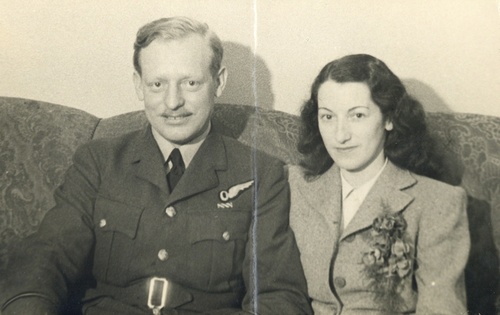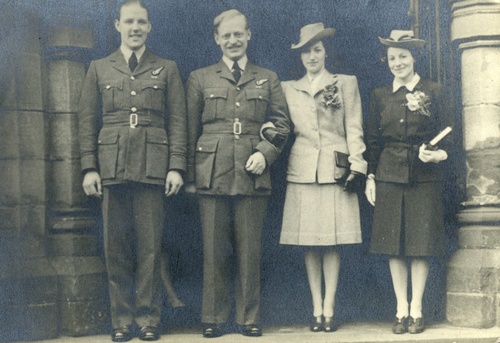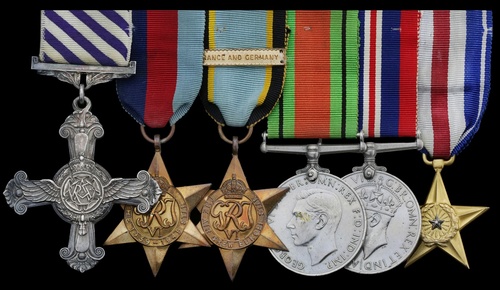Auction: 20001 - Orders, Decorations and Medals - conducted behind closed doors
Lot: 741
A Second World War D.F.C. and scarce American Silver Star group of six awarded to Squadron Leader G. Wood, Royal Air Force, late Royal Air Force Volunteer Reserve, who completed over 60 operational sorties, initially with No. 103 Squadron, but latterly as Visual Bombing Leader in No. 35 Squadron, Path Finder Force; his American decoration stemmed from a special mission in 1945, when he brought his Lancaster down to an altitude of 150 feet despite the flak
Distinguished Flying Cross, G.VI.R., reverse officially dated '1943'; 1939-45 Star; Air Crew Europe Star, copy clasp, France and Germany; Defence and War Medals 1939-45; United States of America, Silver Star, the last with case of issue, mounted as worn, good very fine (12)
D.F.C. London Gazette 14 September 1943. The original recommendation by the Wing Commander, Commanding, No. 103 Squadron, Bomber Command, Elsham Wolds, states:
'Flying Officer Wood has now completed 25 operational sorties, the targets including Berlin (twice), Kiel, Hamburg and most of the heavily defended Ruhr targets.
Under a calm and quiet manner this officer possesses a fine offensive spirit in action and a staunch determination to press home his attacks with the greatest possible accuracy and effectiveness. His high sense of duty and the conscientious manner in which he carries out his work both in the air and on the ground have set a very fine example in the Squadron.
His fine record of achievement deserves high praise and I recommend him for the non-immediate award of the Distinguished Flying Cross.'
The Station Commander adds:
'An imperturbable and reliable Officer who has set a fine example to his crew by his coolness in action and his keen desire to bomb and photograph the target regardless of opposition. His fine steady record and his high example fully merit the award of the Distinguished Flying Cross.'
Silver Star London Gazette 10 June 1946. The original recommendation by Major-General Idwal H. Edwards on 2 April 1946, states:
'Since he was awarded the D.F.C., Squadron Leader Wood has completed 33 operational sorties as an Air Bomber in heavy bombers. Many of these attacks have been made in the Master Bomber aircraft and some have been in support of American ground forces. On the night of 24th May (sic) 1945, Squadron Leader Wood volunteered for a special mission which involved the dropping of much needed supplies into the hospital compound of the Prisoners of War Camp at Neubrandenburg. The mission was not granted safe conduct by the enemy and involved a long flight at very low altitude rarely in excess of 500ft. The successful dropping of the containers into a very small area was completed by Squadron Leader Wood after a most accurate run up to the target at an altitude of 150ft.'
29 awards of the Silver Star to the R.A.F. during the Second World War.
Gilbert Wood was born on 7 December 1909 at Morton Banks, the son of John and Catherine Wood of 1 Low Banks, Morton Banks, Keighley, Yorkshire. He enlisted into the Royal Air Force Volunteer Reserve as Aircraftman 2nd Class and Observer on 15 October 1941, and was discharged on appointment to an Emergency Commission as Pilot Officer on probation in the General Duties Branch of the Volunteer Reserve on 17 August 1942. Promoted Flying Officer on 18 February 1943, he was sent to his first operational posting with No. 103 Squadron, a Lancaster unit based at Elsham Woods in Lincolnshire, soon thereafter.
Wood flew his first operational bombing sortie to Hamburg on 3 March 1943. Two days later he attacked the Krupp steelworks at Essen which at that time was instrumental in manufacturing tanks, artillery, naval guns, armour plate, munitions and other essential items for the German military. The early success of repeated bombing forced the enemy to build a large night-time decoy site on the outskirts of the City known as the Kruppsche Nachtscheinanlage. This proved a shrewd move, for over the following years it is believed that 64% of all high-explosive bombs and 75% of all incendiaries fell on the 'fake' factory instead of its authentic counterpart (Hitting the Mark but Missing the Target: Luftwaffe Deception Operations, 1939-45, by E. Westermann, refers).
Thereafter, Wood flew regular bombing sorties to Nurnberg, Munich, Duisberg, Berlin, Kiel, Spezia and Pilsen on 16 April 1943. The latter involved the bombing of the Skoda Armament Works in Czechoslovakia which were producing tanks, heavy guns and ammunition for the Third Reich. At that time the factory was finalising designs for the manufacture of prototypes of the Jagdpanzer 38 - a light tank destroyer based upon the Czechoslovakian Panzer 38 (t) chassis. He undertook an aerial minelaying 'Gardening' sortie on 27 April 1943 and attacked the German City of Wuppertal on 24 June 1943 creating a destructive firestorm. Repeated attacks on the Goldschmitt adhesives factory proved devastating to the city; 38 percent of the built-up urban area of Barmen, Elberfeld and Ronsdorf was destroyed, but the consequential delays in the production of wood adhesives meant the virtual curtailment of the Ta154 Moskito and He162 Spatz aircraft development programmes.
On 25 June 1943, Wood attacked the City of Gelenskirchen in the Ruhr as part of the allied oil campaign. He flew a final brace of strikes to Cologne before being rested and awarded the Distinguished Flying Cross. At some stage Wood returned to action with No. 35 Squadron, Royal Air Force, and brought his tally of sorties up to 62, totalling 320 flying hours. In August 1942, No. 35 Squadron was one of five squadrons selected to create the Pathfinder Force. Based at R.A.F. Graveley near Huntingdon, the Squadron converted from Halifax aircraft to the Avro Lancaster in March 1944. Wood is known to have acted around this time as the Squadron's Visual Bombing Leader - a position of great responsibility, especially when the success or failure of British raids now largely depended on the Pathfinder's marker placement and further correction marking.
Wood was released from the Royal Air Force in February 1948. He was later recalled to the active list and was not finally returned to the retired list until November 1965. He died of heart disease on 11 September 1982 at the Whittington Hospital, Islington, his wife Margaret, of 166 Fortis Green Road, Muswell Hill, London, registering his passing.
Sold together with corresponding mounted miniature dress medals, a contemporary Certified Copy birth certificate, original typed notification of award letter from the American Embassy, Office of the Military Attache, dated 31 October 1946, notifying Wood of the conferment of the Silver Star Medal, 'Restricted' typed copy document of all awards of the Silver Star, dated 2 April 1946, Record of Service document from R.A.F. Officer's Records, officially stamped and dated 21 September 1966, original letter from the Ministry of Defence, Whitehall, thanking Wood on behalf of Her Majesty The Queen for his long and valuable service, dated 30 November 1965, in original envelope of transmittal, 2 contemporary photographs of the recipient in R.A.F. uniform, with his wife, a large and impressive illuminated certificate from USAF Strategic Command, 3918th Combat Support Group, Upper Heyford, on the Relinquishing of Squadron Leader Wood's responsibility as R.A.F. Controller at Upper Heyford on 19 April, 1963.
Subject to 20% VAT on Buyer’s Premium. For more information please view Terms and Conditions for Buyers.
Sold for
£1,900
Starting price
£800









